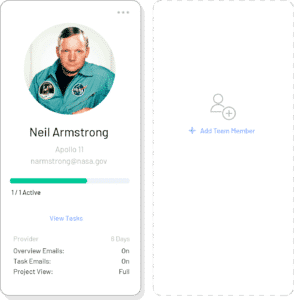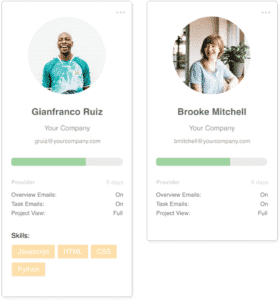
Did you know that simply increasing customer retention rates by 5 percent increases profits by 25 to 95 percent for an organization? The high-ROI act of engaging and retaining a client begins with the client onboarding process.
However, well-executed customer onboarding doesn’t just happen. It requires a well-thought-out plan, including templates and customization options, a strong customer success team, an assertive kickoff strategy, and measurable success goals that both the customer and you understand.
You cannot underestimate the importance of a customer success plan when onboarding your clients. It can make the difference between developing a long-term relationship with a customer and losing a customer during the process. Let’s talk more about the successful customer success plan, including what it is, how to create one, and the role of team buy-in.
Defining a Customer Success Plan
The client’s journey through the onboarding process and their future success depend heavily on starting with the right customer success plan. Think of your customer success plan as a map/compass and your business as a ship: You’d never embark on a voyage without knowing how to get where you’re going, how long it will take, and how you’ll know you’re going the right way. A customer success plan outlines all those details for the customer success manager (the captain), the team (the crew), and, most importantly, the client (the passengers).
According to the client, a customer success plan starts with the “what” or the definition of success. Your client will measure success from the moment they realize the true value. That initial win becomes their “what.” Further defining that measurement of success is the first step of any customer success plan.
The customer success plan will become the map for the onboarding process. Let’s discuss why this plan is so important to an organization.
How a Customer Success Plan Works
Designed properly and implemented correctly, the customer success plan defines measurable goals. Without milestones built into the system and measurements for defining success, it is nearly impossible to determine how well the plan works and if the client has achieved their “value add” expectation.
A well-executed plan also creates consistency in the process and decreases the chance of mistakes or losing a client during the onboarding process due to procedural gaps. Without a plan, you and your client waste valuable time that could be spent on additional value-adding tasks. Clients will feel more confident and comfortable with an organization that has created a concise and cohesive onboarding process and customer success plan. This professional approach will also lend credibility to your business and brand.
Essential Elements of a Customer Success Plan
While customer success plans will differ from organization to organization and industry to industry, there are some essential elements that every plan should include.
- Customer Definition. Your customer is the very heart of your business. Understanding who they are, their organizational culture, their strategic goals, and their resources are essential to any customer success plan. Neglecting to define your customer clearly can lead to gaps in the goals and methodology of onboarding. An improper definition of client needs can also lead to frustration on the client’s part, leading to customer turnover. ㅤ
- Value Definition. Understanding how the customer defines success will be key to your plan. If you determine the goal is one thing and the client determines it to be another, then failure to achieve success is imminent. Everyone needs to be on the same page when defining success for this step within the customer success plan. A strong customer success team or manager will understand the client’s pain points and be able to suggest metrics or milestones that can define success. ㅤ
- Step-by-Step Plan. Imagine assembling a piece of furniture without step-by-step instructions. What you thought would be a media console may become a pile of separate parts and pieces. Likewise, a customer success plan needs step-by-step processes that the client and customer success manager follow together. These steps keep the process moving forward and ensure the program is efficient and on task. If the client is ever confused by why a specific action is being taken, the manager can easily refer them to the steps outlined in the plan. ㅤ
- Assignments. Imagine the chaos and confusion if everyone shows up to the company potluck and no one is assigned to bring paper plates! The client and the customer success team should “own” the steps outlined in the process. Include specifics such as deliverables, due dates, and clear instructions, so everyone knows their assignments. This will increase buy-in for the plan, which we will discuss later.
- Ongoing Communication. Essential to keep the plan moving forward is communication. Discuss concerns and questions the client may have. Keep track of those conversations and respond in a timely manner so the client can continue their forward progress during the onboarding process.
While these are the most essential elements of a customer success plan, additional elements could include the budget, progress reports/updates, follow-up timelines, and more.
How to Create a Customer Success Plan
Using the elements discussed above, it’s time to build your plan. Here is an example of how you might approach building a Customer Success Plan.
Work with the client to define who they are and what they need. Include the client’s name, contact information, details about the products and services they have purchased, clear descriptions of their pain points, and a definition of success.
Write out the steps to move the client from start to finish. Build or use a template that includes all of the steps in the process. (Software that automates this process makes this much easier.)

Invite all stakeholders to the project. Make assignments and give ownership to both the team and the client. Include due dates, notes, and other necessary details.

Ensure communication is built into the system. This will help everyone stay on task and address issues quickly and easily.
Consider implementing success reporting to reward the client for completing the process. A progress report or status update is a great way to encourage the client to continue onboarding.
How to Get Buy-In for a Customer Success Plan
Astonishingly, 70 percent of all organizational change efforts fail. One key reason is the lack of buy-in for initiatives and ideas. Without buy-in, a customer success plan is likely doomed to fail.
Not every stakeholder may understand the importance of a plan when it comes to customer onboarding. Even the slightest lack of buy-in can lead to pushback from employees—whether your own or the clients’. For your plan to be successful, you will need buy-in from all involved parties.
Buy-in is most likely to occur when those involved have contributed to the plan’s creation. Begin with the problem you are addressing. If people understand the pain points driving the plan, they are far more likely to embrace the strategy. Be open to criticism, questions, and suggestions. Additional eyes on the plan will ensure that future issues can be avoided. A different perspective can also help you understand how the plan affects different departments and allows you to implement steps to reassure all stakeholders. Keep everyone in the loop as you make changes to the plan, so they feel continued ownership of the project. When all opinions have been heard, and the plan has been altered to benefit all, buy-in is far more likely to occur.
In addition to buy-in from internal stakeholders, ensuring the client understands the “why” of the plan will also be essential. Client who recognizes their success hinges on completing the onboarding process will be more willing and engaged in implementing the overall plan.
How to Turn a Customer Success Plan into a Program
Implementation. Once you’ve created your plan, it’s time to implement it. This is a time of experimentation and tweaking to design the best plan possible.
Customer Feedback. Customer feedback will help you define the ultimate success of the plan. Don’t be afraid of negative feedback. Use all feedback as a platform for improvement and growth.
Onboarding Software. Onboarding software can assist you in creating a program from your plan. To ensure everyone is on board and that buy-in continues, the Customer Success Manager or Team should be trained on the software and be educated on the plan.
Continuous Improvement. Continue working with the team until everyone feels comfortable with the system. Listen to the team’s questions and concerns about the process and implement changes and improvements as needed.
With a customer success plan in place, time that was once spent on onboarding frustrations can now be invested in client relationships. Decreased frustrations and roadblocks in the process lead to a happy customer. A happy customer leads to increased retention. Increased retention leads to increased profits. Designing and implementing a customer success plan is a win for everyone.
To ensure you put the perfect plan in place, you’ll want an approach that allows you to customize and build the exact process you need from start to finish.
Talk With a Guide Today
Discover how GUIDEcx can help you improve efficiency by reducing your customer onboarding timeline and increasing the capacity of your project managers. Our unparalleled professional resources and unwavering commitment to excellence support our industry-leading customer onboarding solution.
